#Megalosauroidea
Text

Condorraptor currumili making dinner plans in Early Jurassic Argentina
#dinosaur#illustration#paleoart#paleontology#paleoillustration#paleoblr#palaeoblr#art#palaeontology#theropod#megalosauroidea#jurassic world#jurassic period#dinosaurs#dinosauria#argentina
603 notes
·
View notes
Text
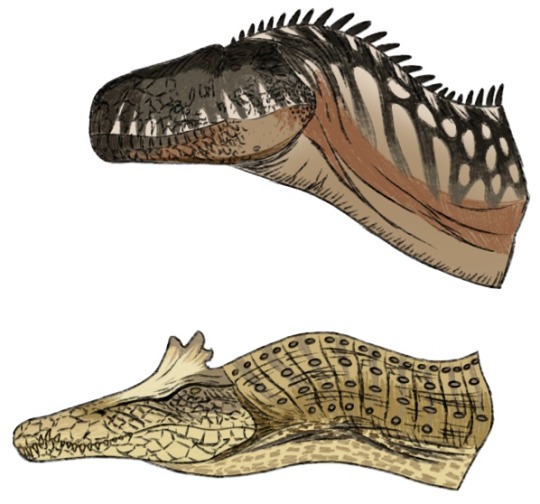
Torvosaurus and Spinosaurus comparison, since they’re both in Megalosauroidea (I think, correct me if I’m wrong). Used the Prehistoric Kingdom designs because that game needs more fanart I thinks /gen
#torvosaurus#spinosaurus#megalosauroidea#dinosaur#dinosaurs#prehistoric kingdom#paleoart#digital drawing#digital doodle#digital doodles
584 notes
·
View notes
Text
Riojavenatrix lacustris Isasmendi et al., 2024 (new genus and species)


(Shin and ankle bones [top, scale bars = 10 cm in A–O and 5 cm in P–T], and schematic skeletal by Scott Hartman [bottom], of Riojavenatrix lacustris, with preserved bones in fuchsia on the skeletal, from Isasmendi et al., 2024)
Meaning of name: Riojavenatrix = La Rioja huntress [in Latin]; lacustris = of lakes [in Latin]
Age: Early Cretaceous (probably Aptian)
Where found: Virgen del Villar-1, La Rioja, Spain
How much is known: Partial skeleton of one individual including some of the hindlimbs, fragments of the hips, and a partial back vertebra.
Notes: Riojavenatrix was a spinosaurid, a group of large theropods with specializations for feeding in aquatic habitats. It is one of many Early Cretaceous spinosaurids that have been found in the Iberian Peninsula, along with Vallibonavenatrix, Camarillasaurus, and Protathlitis, which are also from Spain, and Iberospinus from Portugal. Out of these, Riojavenatrix is likely youngest known spinosaurid from this time and region.
Reference: Isasmendi, E., E. Cuesta, I. Díaz-Martínez, J. Company, P. Sáez-Benito, L.I. Viera, A. Torices, and X. Pereda-Suberbiola. 2024. Increasing the theropod record of Europe: a new basal spinosaurid from the Enciso Group of the Cameros Basin (La Rioja, Spain). Evolutionary implications and palaeobiodiversity. Zoological Journal of the Linnean Society advance online publication. doi: 10.1093/zoolinnean/zlad193
92 notes
·
View notes
Text
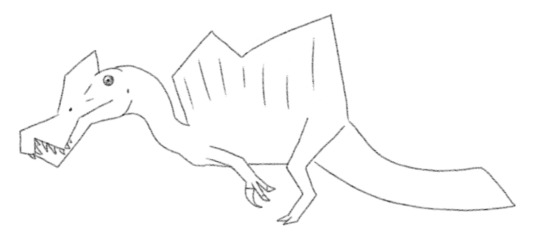
Having an art block, take this stylised Spinosaurus while I try to get motivation to make something detailed
#dinosaurs#paleoart#digital art#paleontology#spinosaurus#spinosauridae#theropod#carnosaur#megalosauroidea
20 notes
·
View notes
Text

Megalosaurus bucklandii done in August for my friend's Birthday. This is the first non-avian dinosaur named (back in 1827). Since then, many specimens from Europe, North America and Africa have been attributed to it (among them Dilophosaurus, Carcharodontosaurus and even Plateosaurus), but today this species is limited to material from the Middle Jurassic of Oxfordshire (England). Initially, Megalosaurus was represented as a four-legged reptile, similar to a crocodile with the limbs of a large mammal. Now its appearance seems completely different. Despite its historical significance, Megalosaurus is still not well studied.
Paint Tool Sai 2.0, 2023.
#megalosaurus bucklandii#megalosaurus#torvosaurus#eustreptospondylus#megalosauridae#megalosauroidea#theropod#late jurassic#paleoart
19 notes
·
View notes
Photo

It’s about time for about 12 years now, and that Oxalaia finally stepped out of Spino’s shadow, and now it’s appearance had finally changed, now it looks less like Spinosaurus.
2 notes
·
View notes
Text
Still trying to finish an artpiece inspired by a small part of that one paper that proposed compsognathidae isn't a valid taxonomic group gh
#fyi the part this is inspired by is the “scipionyx is a spinosaurid/closer to spinosaurids than the rest of the ”compsognathids“ who#were placed in megalosauroidea were
4 notes
·
View notes
Text
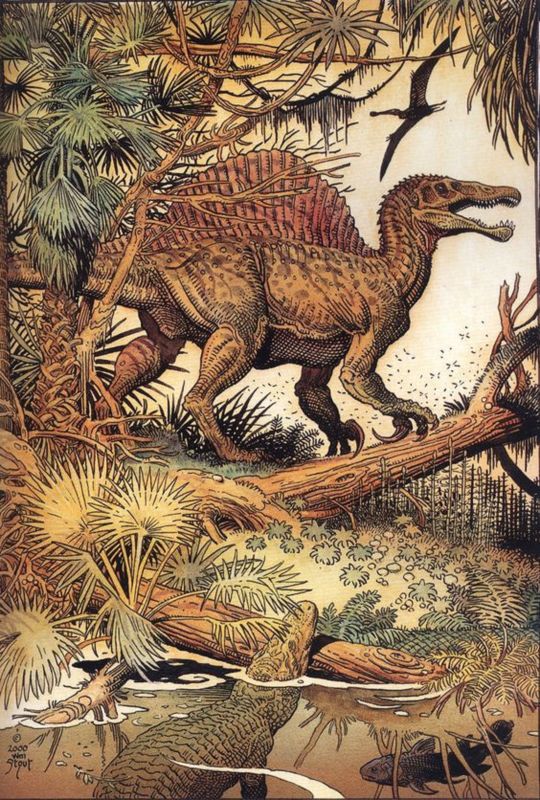
SPY-noh-SOAR-uss -- THE "SPINY LIZARD" OF PRESENT DAY NORTH AFRICA.
PIC INFO: Resolution at 1692x2508 -- Spotlight on Spinosaurus (meaning "spine lizard"), a genus of theropod dinosaur that lived in what now is North Africa during the upper Albian to upper Turonian stages of the Cretaceous period, about 112 to 93.5 million years ago.
The best known species is S. aegyptiacus from Egypt, although a potential second species, S. maroccanus, has been recovered from Morocco. Artwork by William Stout, c. 2000.
Name: Spinosaurus (Spine lizard)
Phonetic: Spine-oh-sore-us.
Named By: Ernst Stromer - 1915.
Synonyms: Sigilmassasaurus?
Classification: Chordata, Reptilia, Dinosauria, Saurischia, Theropoda, Megalosauroidea, Spinosauridae, Spinosaurinae.
Species: S. aegyptiacus (type), S. maroccanus is a possible second, although many consider this species as being the same as the type species.
Diet: Piscivore/Carnivore.
Size: Estimates highly variable amongst sources and range anywhere between 12.6 and 18 meters total body length. Skull length estimated between 1.5 and 1.75 meters long.
Known locations: North Africa, particularly Egypt - Bahariya Formation, and Morocco - Kem Kem Beds.
Time period: Albian to Cenomanian of the Cretaceous.
Fossil representation: To date at least six partial specimens of the skull, mandible, neural spines and other fragmentary post cranial remains. Teeth however are considerably more common.
Sources: www.prehistoric-wildlife.com/species/s/spinosaurus.html, www.mindat.org/taxon-4967112.html, & Pinterest.
#Spinosaurus#WilliamStout#DinoArt#Palaeoart#SpinosaurusAegyptiacus#S.aegyptiacus#PalaeoArt#Dinosaur#Theropod#Dinosaurs#LateCretaceous#WilliamStoutArt#Paleoart#DinosaurArt#Spinosaurusaegypticus#Spinosauridae
5 notes
·
View notes
Photo

It's time for Retro vs Modern Month!
Every weekday this March we'll be looking at some examples of how our paleontological understanding and visual depiction of various fossil creatures has evolved over the years.
Starting with…
Retro vs Modern #01: Megalosaurus bucklandii
Fragmentary fossil remains of dinosaurs have been found in Southeast England for hundreds of years, but it wasn't until the 1820s that they were properly recognized as belonging to an ancient "great lizard" given the name Megalosaurus bucklandii – the very first non-avian dinosaur known to science, almost two decades before the term "dinosaur" would even be created to categorize these extinct animals.
1850s
The Victorian Crystal Palace reconstruction of Megalosaurus is often mocked for its inaccurate bulky appearance, but for its time it was actually an incredibly progressive vision of a predatory dinosaur. It was depicted as an alert, active, bear-like beast with upright muscular limbs, and a humped back based on what later turned out to actually be remains of a different dinosaur species.
1890s-1960s
Discoveries of other large theropod dinosaurs revealed their bipedal posture, and Megalosaurus reconstructions were revised to show an upright kangaroo-like stance. But despite some other early portrayals of active agile dinosaurs, the overall opinion of these animals began to drift during the first half of the 20th century towards sluggish tail-dragging reptiles: depicting them as slow, stupid, cold-blooded, awkward and obsolete evolutionary failures whose extinction had been inevitable.
2020s
Starting in the late 1960s the Dinosaur Renaissance finally began to shift thinking back towards active and warm-blooded dinosaurs, recognizing theropods' close evolutionary relationship to modern birds and correcting their posture into a horizontal stance with a counterbalancing tail. And while Megalosaurus itself is still only known from fragments, discoveries of more completely preserved relatives like Torvosaurus have given us a much better idea of what it was probably like.
We know know Megalosaurus lived on what at the time was a subtropical island in the shallow western Tethys Sea, about 166 million years ago during the Mid Jurassic. It would have been around 8m long (~26'), with a long narrow snout, and short muscular arms with enlarged meathook-like thumb claws. Its legs and tail would have been fairly thick and bulky, and it may have had a covering of hair-like protofeathers on its body.
———
Nix Illustration | Tumblr | Twitter | Patreon
#retro vs modern 2022#science illustration#paleontology#paleoart#palaeoblr#megalosaurus#megalosauridae#megalosauroidea#carnosaur#theropod#dinosaur#art#retrosaurs
1K notes
·
View notes
Photo
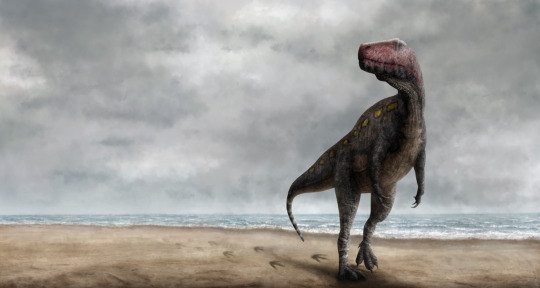
Megalosaurus, the first dinosaur genus named back in 1824, strolling alongside a beach, unaware of it's future scientific significance.
#my art#megalosaurus#paleoart#dinosaur#sciart#theropod#carnosaur#carnivore#megalosauroidea#jurassic#england#prehistoric#extinct#animal#nature#digital art#landscape
82 notes
·
View notes
Photo
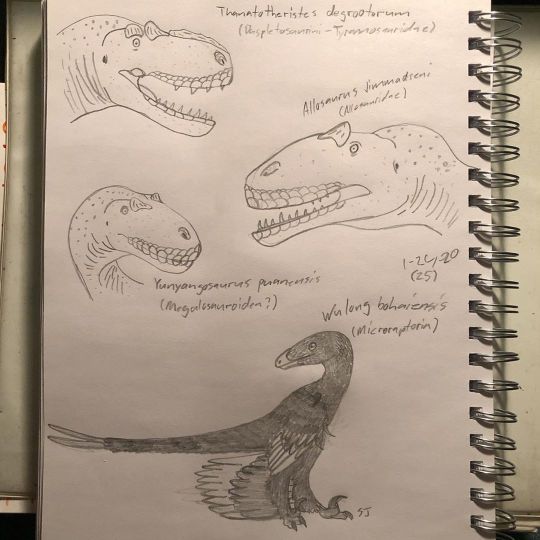
The non-avian theropods of January 2020. #paleoart #sketchbook #myart #theropoda #tyrannosauridae #allosauridae #megalosauroidea #carnosauria #coelurosauria #microraptoria #dromaeosauridae #avetheropoda https://www.instagram.com/p/B7xJDZtlwf1/?igshid=r3effaotoufv
#paleoart#sketchbook#myart#theropoda#tyrannosauridae#allosauridae#megalosauroidea#carnosauria#coelurosauria#microraptoria#dromaeosauridae#avetheropoda
1 note
·
View note
Photo


New Spinosaurus rendition
Featured on my latest Youtube video dedicated to Megalosauroidea
Instagram
Patreon
Youtube channel
Prints and more paleoart merch
104 notes
·
View notes
Text
Protathlitis cinctorrensis Santos-Cubedo et al., 2023 (new genus and species)
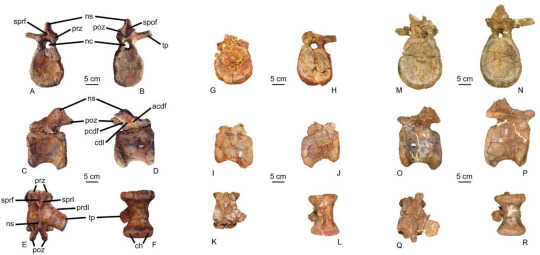
(Tail vertebrae of Protathlitis cinctorrensis, from Santos-Cubedo et al., 2023)
Meaning of name: Protathlitis = champion [in Greek, referencing the centenary of the Villarreal football club, which won the UEFA Europa League in 2021]; cinctorrensis = from Cinctorres
Age: Early Cretaceous (Barremian), about 126–127 million years ago
Where found: Arcillas de Morella Formation, Valencian Community, Spain
How much is known: An upper jaw fragment and five tail vertebrae of one individual, as well as an isolated tooth.
Notes: Protathlitis was a spinosaurid, a group of large theropods with specializations for feeding in aquatic habitats. Along with Vallibonavenatrix and Camarillasaurus, which are also from Spain, Iberospinus from Portugal, and Baryonyx, Ceratosuchops, and Riparovenator from England, Protathlitis adds to the growing understanding that spinosaurids were highly diverse in western Europe during the Early Cretaceous.
Reference: Santos-Cubedo, A., C. de Santisteban, B. Poza, and S. Meseguer. 2023. A new spinosaurid dinosaur species from the Early Cretaceous of Cinctorres (Spain). Scientific Reports 13: 6471. doi: 10.1038/s41598-023-33418-2
50 notes
·
View notes
Text
Irritator challengeri
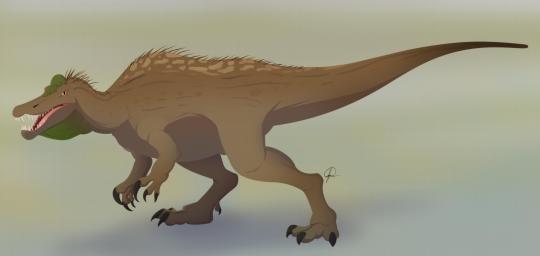
By José Carlos Cortés
Etymology: The One That Irritated
First Described By: Martill et al., 1996
Classification: Dinosauromorpha, Dinosauriformes, Dracohors, Dinosauria, Saurischia, Eusaurischia, Theropoda, Neotheropoda, Averostra, Tetanurae, Orionides, Megalosauroidea, Megalosauria, Spinosauridae, Spinosaurinae
Status: Extinct
Time and Place: Between 110 and 108 million years ago, in the Albian of the Early Cretaceous

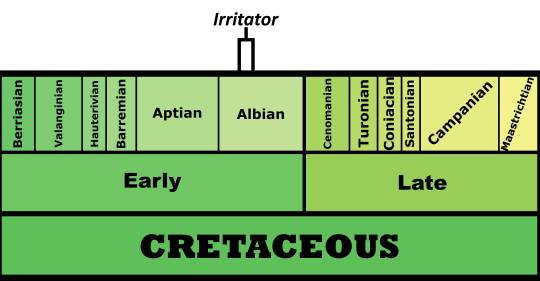
Irritator is known from the Romualdo Member of the Santana Formation in Brazil

Physical Description: Irritator was a Spinosaurid, so the weird crocodile-mimicking theropods that roamed the Cretaceous landscape across the Southern hemisphere (and some of Europe). Irritator, however, is not known from very much material, despite having loads written about it. It was one of the smaller members of the Spinosaur group, only about 7.5 meters long and not weigh more than one tonne - which may actually indicate it could have still had some sort of fluffy integument, though this still seems unlikely based on its ecology. As a Spinosaur, Irritator would have been fairly bulky, with a long and vaguely crocodilian skull. Its skull also featured a long thin crest going from the midline to the eye, where it flattened into a bulge - this was probably some sort of display structure. Little is known of the rest of its skeleton, but it is known to have had a long and well-clawed hand. It probably had some sort of sail on its back, but it probably was a shorter one, and whether or not its legs were a normal size is unknown.

By Alexander Vieira, CC BY-SA 4.0 (Irritator is on the far right, in green)
Diet: Irritator would have mainly fed upon fish and other aquatic organisms.
Behavior: Irritator, being a Spinosaur, spent most of its time in the water, swimming about and searching for food. Since it was rather small, it would have been able to fit in smaller streams of water than most of its other relatives. Though, since it probably still had fairly decent legs, it also would have spent a good amount of time on the land, surveying the shore for food and seeking out prey. Its long snout would then be used to grab fish and other animals from the water, using the lightweight instrument to grab food it might not be able to reach otherwise. While swimming, it would be able to use that snout to reach even more food than before, ducking its head underwater or doing the reverse to hide from land sources of prey. Its very powerful neck muscles would have also been extremely helpful in grabbing and holding onto thrashing prey.

By Fred Wierum, CC BY 3.0
Irritator was probably warm-blooded, and used its sail more for display than for keeping warm. This display structure may have been able to change color based on blood circulation or environment in order to send different messages to other members of the species. The crest on the center of the snout also probably served similar features, for displaying to one another. It seems likely that Irritator, like most other dinosaurs, took care of its young; but there is no evidence either way to support that hypothesis.
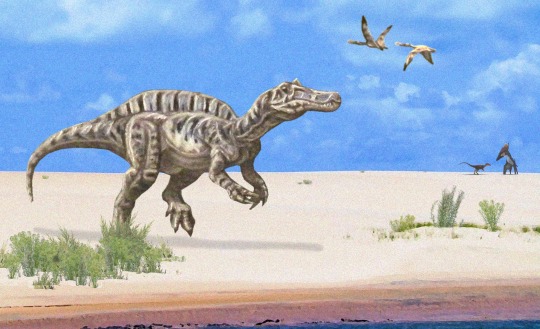
By PaleoGeekSquared, CC BY 3.0
Ecosystem: Irritator lived in the Romualdo Environment of Brazil, which was a basin of lakes surrounded by rivers and other wetland environments, filled to the brim with a wide variety of plantlife. Nearby was the burgeoning Atlantic Ocean, making this a Spinosaur’s favorite place of all. Here there were a wide variety of early flowering plants like magnolias, seagrasses, and lilies - all of which were associated heavily with this aquatic environment. There were many types of ray-finned fish, which would have been the primary source of prey for Irritator, as well as lobe-finned fish which would have also been decent sources of food. Sharks seem to have been rare. There were plenty of turtles too, including one of the earliest sea turtles Santanachelys. This was the land of extreme pterosaurs, including Anhanguera, Arirpesaurus, Barbosania, Brasileodactylus, Cearadacytlus, Maaradactylus, Santanadactylus, Tapejara, Thalassodromeus, Tropeognathus, Tupuxuara, and Unwindia. There was also a Notosuchian, Araripesuchus. There were other dinosaurs there too - the compsognathid Mirischia and the Tyrannosauroid Santanaraptor, which would have mainly fed on small animal prey.

By Scott Reid
Other: Irritator was found as part of the illegal fossil trade, initially mistake for a pterosaur, then a maniraptoran, before being finally identified as a spinosaur. The confusion surrounding this fossil - and the fact that the snout had been artificially elongated by the fossil traders - lead to its name. Its position within the Spinosaurs is well supported, and it seems to have been at least somewhat closely related to Spinosaurus itself, rather than Baryonyx on the other end of the family tree.
~ By Meig Dickson
Sources under the Cut
Allain, Ronan; Xaisanavong, Tiengkham; Richir, Philippe; Khentavong, Bounsou (2012-04-18). "The first definitive Asian spinosaurid (Dinosauria: Theropoda) from the early cretaceous of Laos". Naturwissenschaften. 99 (5): 369–377.
Amiot, R.; Buffetaut, E.; Lécuyer, C.; Wang, X.; Boudad, L.; Ding, Z.; Fourel, F.; Hutt, S.; Martineau, F.; Medeiros, A.; Mo, J.; Simon, L.; Suteethorn, V.; Sweetman, S.; Tong, H.; Zhang, F.; Zhou, Z. (2010). "Oxygen isotope evidence for semi-aquatic habits among spinosaurid theropods". Geology. 38 (2): 139–142.
Arden, T.M.S.; Klein, C.G.; Zouhri, S.; Longrich, N.R. (2018). "Aquatic adaptation in the skull of carnivorous dinosaurs (Theropoda: Spinosauridae) and the evolution of aquatic habits in Spinosaurus". Cretaceous Research. In Press: 275–284.
Aureliano, Tito; Ghilardi, Aline M.; Buck, Pedro V.; Fabbri, Matteo; Samathi, Adun; Delcourt, Rafael; Fernandes, Marcelo A.; Sander, Martin (2018-05-03). "Semi-aquatic adaptations in a spinosaur from the Lower Cretaceous of Brazil". Cretaceous Research. 90: 283–295.
Bantim, Renan A.M.; Saraiva, Antônio A.F.; Oliveira, Gustavo R.; Sayão, Juliana M. (2014). "A new toothed pterosaur (Pterodactyloidea: Anhangueridae) from the Early Cretaceous Romualdo Formation, NE Brazil". Zootaxa. 3869 (3): 201–223.
Barrett, Paul; Butler, Richard; Edwards, Nicholas; Milner, Andrew R. (2008-12-31). "Pterosaur distribution in time and space: An atlas". Zitteliana Reihe B: Abhandlungen der Bayerischen Staatssammlung Fur Palaontologie und Geologie. 28: 61–107.
Benson, R.B.J.; Carrano, M.T.; Brusatte, S.L. (2009). "A new clade of archaic large-bodied predatory dinosaurs (Theropoda: Allosauroidea) that survived to the latest Mesozoic". Naturwissenschaften. 97 (1): 71–78.
Benyoucef, Madani; Läng, Emilie; Cavin, Lionel; Mebarki, Kaddour; Adaci, Mohammed; Bensalah, Mustapha (2015-07-01). "Overabundance of piscivorous dinosaurs (Theropoda: Spinosauridae) in the mid-Cretaceous of North Africa: The Algerian dilemma". Cretaceous Research. 55: 44–55.
Bertin, Tor (2010-12-08). "A catalogue of material and review of the Spinosauridae". PalArch's Journal of Vertebrate Palaeontology. 7.
Bertozzo, F., B. Favaretto, M. Bon and FM Dalla Vecchia. 2013. The wallpaper of Ouranosaurus nigeriensis Taquet, 1976 (Ornithischia, Ornithopoda) exhibited at the Natural History Museum of Venice: history of the find and perspectives for detailed studies [The paratype of Ouranosaurus nigeriensis Taquet, 1976 (Ornithischia, Ornithopoda) exhibited at the Museum of Natural History of Venice: history of discovery and prospects for detailed studies]. Bulletin of the Natural History Museum of Venice 64 : 119-130
Bittencourt, Jonathas; Kellner, Alexander (2004-01-01). "On a sequence of sacrocaudal theropod dinosaur vertebrae from the Lower Cretaceous Santana Formation, northeastern Brazil". Arq Mus Nac. 62: 309–320.
Brito, Paulo; Yabumoto, Yoshitaka (2011). "An updated review of the fish faunas from the Crato and Santana formations in Brazil, a close relationship to the Tethys fauna". Bulletin of Kitakyushu Museum of Natural History and Human History, Ser. A. 9.
Buffetaut, E.; Ouaja, M. (2002). "A new specimen of Spinosaurus (Dinosauria, Theropoda) from the Lower Cretaceous of Tunisia, with remarks on the evolutionary history of the Spinosauridae" (PDF). Bulletin de la Société Géologique de France. 173 (5): 415–421.
Buffetaut, E.; Martill, D.; Escuillié, F. (2004). "Pterosaurs as part of a spinosaur diet". Nature. 430 (6995): 33.
Candeiro, C. R. A., A. G. Martinelli, L. S. Avilla and T. H. Rich. 2006. Tetrapods from the Upper Cretaceous (Turonian–Maastrichtian) Bauru Group of Brazil: a reappraisal. Cretaceous Research 27:923-946
Candeiro, C. R. A., A. Cau, F. Fanti, W. R. Nava, and F. E. Novas. 2012. First evidence of an unenlagiid (Dinosauria, Theropoda, Maniraptora) from the Bauru Group, Brazil. Cretaceous Research 37:223-226
Carrano, M. T., R. B. J. Benson, and S. D. Sampson. 2012. The phylogeny of Tetanurae (Dinosauria: Theropoda). Journal of Systematic Palaeontology 10(2):211-300
Charig, A.J.; Milner, A.C. (1997). "Baryonyx walkeri, a fish-eating dinosaur from the Wealden of Surrey". Bulletin of the Natural History Museum of London. 53: 11–70.
Cuff, Andrew R.; Rayfield, Emily J. (2013-05-28). "Feeding Mechanics in Spinosaurid Theropods and Extant Crocodilians". PLoS ONE. 8 (5): e65295.
Dal Sasso, Cristiano; Maganuco, Simone; Buffetaut, Eric; Mendez, Marco A. (2005-12-30). "New information on the skull of the enigmatic theropod Spinosaurus, with remarks on its size and affinities". Journal of Vertebrate Paleontology. 25 (4): 888–896.
de Lapparent de Broin, F. (2000). "The oldest pre-Podocnemidid turtle (Chelonii, Pleurodira), from the early Cretaceous, Ceará state, Brasil, and its environment". Treballs del Museu de Geologia de Barcelona. 9: 43–95.
Evers, Serjoscha W.; Rauhut, Oliver W.M.; Milner, Angela C.; McFeeters, Bradley; Allain, Ronan (2015). "A reappraisal of the morphology and systematic position of the theropod dinosaur Sigilmassasaurus from the 'middle' Cretaceous of Morocco". PeerJ. 3: e1323.
Ezcurra, M. D. 2009. Theropod remains from the uppermost Cretaceous of Colombia and their implications for the palaeozoogeography of western Gondwana. Cretaceous Research 30:1339-1344
Figueiredo, R.G.; Kellner, A.W.A. (2009). "A new crocodylomorph specimen from the Araripe Basin (Crato Member, Santana Formation), northeastern Brazil". Paläontologische Zeitschrift. 83 (2): 323–331.
Frey, E.; Martill, D.M. (1994). "A new Pterosaur from the Crato Formation (Lower Cretaceous, Aptian) of Brazil". Neues Jahrbuch für Geologie und Paläontologie, Abhandlungen. 194: 379–412.
Furtado, M. R., C. R. A. Candeiro, and L. P. Bergqvist. 2013. Teeth of Abelisauridae and Carcharodontosauridae cf. (Theropoda, Dinosauria) from the Campanian- Maastrichtian Presidente Prudente Formation (southwestern São Paulo State, Brazil). Estudios Geológicos 69(1):105-114
Gaffney, Eugene S.; de Almeida Campos, Diogenes; Hirayama, Ren (2001-02-27). "Cearachelys, a New Side-necked Turtle (Pelomedusoides: Bothremydidae) from the Early Cretaceous of Brazil". American Museum Novitates. 3319: 1–20.
Gaffney, Eugene S.; Tong, Haiyan; Meylan, Peter A. (2009-09-02). "Evolution of the side-necked turtles: The families Bothremydidae, Euraxemydidae, and Araripemydidae". Bulletin of the American Museum of Natural History. 300: 1–698.
Gibney, Elizabeth (2014-03-04). "Brazil clamps down on illegal fossil trade". Nature. 507 (7490): 20.
Hassler, A.; Martin, J.E.; Amiot, R.; Tacail, T.; Godet, F. Arnaud; Allain, R.; Balter, V. (2018-04-11). "Calcium isotopes offer clues on resource partitioning among Cretaceous predatory dinosaurs". Proc. R. Soc. B. 285 (1876): 20180197.
Henderson, Donald M. (2018-08-16). "A buoyancy, balance and stability challenge to the hypothesis of a semi-aquatic Spinosaurus Stromer, 1915 (Dinosauria: Theropoda)". PeerJ. 6: e5409
Hendrickx, C., and O. Mateus. 2014. Abelisauridae (Dinosauria: Theropoda) from the Late Jurassic of Portugal and dentition-based phylogeny as a contribution for the indentification of isolated theropod teeth. Zootaxa 3759(1):1-74
Hirayama, Ren (1998). "Oldest known sea turtle". Nature. 392 (6677): 705–708.
Holtz, Thomas; Molnar, Ralph E.; Currie, Philip (2004-06-12). "Basal Tetanurae". The Dinosauria: Second Edition. University of California Press. pp. 71–110.
Ibrahim, N.; Sereno, P.C.; Dal Sasso, C.; Maganuco, S.; Fabbri, M.; Martill, D.M.; Zouhri, S.; Myhrvold, N.; Iurino, D.A. (2014). "Semiaquatic adaptations in a giant predatory dinosaur". Science. 345 (6204): 1613–1616.
Kellner, A.W.A.; Campos, D.A. (1996). "First Early Cretaceous dinosaur from Brazil with comments on Spinosauridae". N. Jb. Geol. Paläont. Abh. 199 (2): 151–166.
Kellner, A.W.A. (1996). "Remarks on Brazilian dinosaurs". Memoirs of the Queensland Museum. 39 (3): 611–626.
Kellner, A.W.A.; Campos, D.A. (2000). "Brief review of dinosaur studies and perspectives in Brazil". Anais da Academia Brasileira de Ciências. 72 (4): 509–538.
Kellner, A.W.A. (2001). "New information on the theropod dinosaurs from the Santana Formation (Aptian-Albian), Araripe Basin, Northeastern Brazil". Journal of Vertebrate Paleontology. 21 (supplement to 3): 67A.
Kellner, A.W.A.; Campos, D.A. (2002). "The function of the cranial crest and jaws of a unique pterosaur from the early Cretaceous of Brazil". Science. 297 (5580): 389–392.
Kellner, A. W. A., S. A. K. Azevedo, E. B. Machado, L. B. Carvalho, and D. D. R. Henriques. 2011. A new dinosaur (Theropoda, Spinosauridae) from the Cretaceous (Cenomanian) Alcântara Formation, Cajual Island, Brazil. Anais da Academia Brasileira de Ciências 83(1):99-108
Lee, Yuong-Nam; Barsbold, Rinchen; Currie, Philip J.; Kobayashi, Yoshitsugu; Lee, Hang-Jae; Godefroit, Pascal; Escuillié, François; Chinzorig, Tsogtbaatar (2014). "Resolving the long-standing enigmas of a giant ornithomimosaur Deinocheirus mirificus". Nature. 515 (7526): 257–260.
Lopes, Reinaldo José (September 2018). "Entenda a importância do acervo do Museu Nacional, destruído pelas chamas no RJ". Folha de S.Paulo (in Portuguese).
Mabesoone, J.M.; Tinoco, I.M. (1973-10-01). "Palaeoecology of the Aptian Santana Formation (Northeastern Brazil)". Palaeogeography, Palaeoclimatology, Palaeoecology. 14 (2): 97–118.
Machado, E.B.; Kellner, A.W.A. (2005). "Notas Sobre Spinosauridae (Theropoda, Dinosauria)" (PDF). Anuário do Instituto de Geociências – UFRJ (in Portuguese). 28 (1): 158–173.
Machado, E.B.; Kellner, A.W.A.; Campos, D.A. (2005). "Preliminary information on a dinosaur (Theropoda, Spinosauridae) pelvis from the Cretaceous Santana Formation (Romualdo Member) Brazil". Congresso Latino-Americano de Paleontologia de Vertebrados. 2 (Boletim de resumos): 161–162.
Machado, E.B.; Kellner, A.W.A. (2008). "An overview of the Spinosauridae (Dinosauria, Theropoda) with comments on the Brazilian material". Journal of Vertebrate Paleontology. 28(3): 109A.
Martill, D. M., A. R. I. Cruickshank, E. Frey, P. G. Small, and M. Clarke. 1996. A new crested maniraptoran dinosaur from the Santana Formation (Lower Cretaceous) of Brazil. Journal of the Geological Society, London 153:5-8
Martill, David M. (2011). "A new pterodactyloid pterosaur from the Santana Formation (Cretaceous) of Brazil". Cretaceous Research. 32 (2): 236–243.
Martill, David; Frey, Eberhard; Sues, Hans-Dieter; Cruickshank, Arthur R.I. (2011-02-09). "Skeletal remains of a small theropod dinosaur with associated soft structures from the Lower Cretaceous Santana Formation of NE Brazil". Canadian Journal of Earth Sciences. 37 (6): 891–900.
Mateus, Octávio; Araujo, Ricardo; Natario, Carlos; Castanhinha, Rui (2011-04-21). "A new specimen of the theropod dinosaur Baryonyx from the early Cretaceous of Portugal and taxonomic validity of Suchosaurus". Zootaxa: 54–68.
Medeiros, M. A. 2006. Large theropod teeth from the Eocenomanian of northeastern Brazil and the occurrence of Spinosauridae. Revista Brasileira de Paleontologia 9(3):333-338
Medeiros, Manuel Alfredo; Lindoso, Rafael Matos; Mendes, Ighor Dienes; Carvalho, Ismar de Souza (August 2014). "The Cretaceous (Cenomanian) continental record of the Laje do Coringa flagstone (Alcântara Formation), northeastern South America". Journal of South American Earth Sciences. 53: 50–58.
Milner, Andrew; Kirkland, James (2007). "The case for fishing dinosaurs at the St. George Dinosaur Discovery Site at Johnson Farm". Utah Geological Survey Notes. 39 (3): 1–3.
Naish, D.; Martill, D.M.; Frey, E. (2004). "Ecology, Systematics and Biogeographical Relationships of Dinosaurs, Including a New Theropod, from the Santana Formation (?Albian, Early Cretaceous) of Brazil". Historical Biology. 16 (2–4): 57–70.
Naish, D., and D. M. Martill. 2007. Dinosaurs of Great Britain and the role of the Geological Society of London in their discovery: basal Dinosauria and Saurischia. Journal of the Geological Society, London 164:493-510
Pêgas, R.V.; Costa, F.R.; Kellner, A.W.A. (2018). "New Information on the osteology and a taxonomic revision of the genus Thalassodromeus (Pterodactyloidea, Tapejaridae, Thalassodrominae)". Journal of Vertebrate Paleontology. 38 (2): e1443273.
Rauhut, Oliver W.M. (2003). The interrelationships and evolution of basal theropod dinosaurs. London: The Palaeontological Association.
Rayfield, Emily J.; Milner, Angela C.; Xuan, Viet Bui; Young, Philippe G. (2007-12-12). "Functional morphology of spinosaur 'crocodile-mimic' dinosaurs". Journal of Vertebrate Paleontology. 27 (4): 892–901.
Sales, Marcos A.F.; Lacerda, Marcel B.; Horn, Bruno L.D.; de Oliveira, Isabel A.P.; Schultz, Cesar L. (2016-02-01). "The 'χ' of the Matter: Testing the Relationship between Paleoenvironments and Three Theropod Clades". PLOS ONE. 11 (2): e0147031.
Sales, Marcos (2017). "Contribuições à paleontologia de Terópodes não-avianos do Mesocretáceo do Nordeste do Brasil" (in Portuguese). 1. Universidade Federal do Rio Grande do Sul: 54.
Sales, Marcos A.F.; Schultz, Cesar L. (2017-11-06). "Spinosaur taxonomy and evolution of craniodental features: Evidence from Brazil". PLOS ONE. 12 (11): e0187070.
Sánchez-Hernández, B., M. J. Benton, and D. Naish. 2007. Dinosaurs and other fossil vertebrates from the Late Jurassic and Early Cretaceous of the Galve area, NE Spain. Palaeogeography, Palaeoclimatology, Palaeoecology 249:180-215
Sayão, Juliana; Saraiva, Antonio; Silva, Helder; Kellner, Alexander (2011). "A new theropod dinosaur from the Romualdo Lagerstatte (Aptian-Albian), Araripe Basin, Brazil". Journal of Vertebrate Paleontology. 31: supplement 2: 187.
Sereno, P.C.; Beck, A.L.; Dutheuil, D.B.; Gado, B.; Larsson, H.C.; Lyon, G.H.; Marcot, J.D.; Rauhut, O.W.M.; Sadleir, R.W.; Sidor, C.A.; Varricchio, D.; Wilson, G.P.; Wilson, J.A. (1998). "A long-snouted predatory dinosaur from Africa and the evolution of spinosaurids". Science. 282 (5392): 1298–1302.
Serrano-Martínez, Alejandro; Vidal, Daniel; Sciscio, Lara; Ortega, Francisco; Knoll, Fabien (2015). "Isolated theropod teeth from the Middle Jurassic of Niger and the early dental evolution of Spinosauridae". Acta Palaeontologica Polonica.
Sues, H.D.; Frey, E.; Martill, D.M.; Scott, D.M. (2002). "Irritator challengeri, a spinosaurid (Dinosauria: Theropoda) from the Lower Cretaceous of Brazil". Journal of Vertebrate Paleontology. 22 (3): 535–547.
Witmer, L.M. 1995.The Extant Phylogenetic Bracket and the Importance of Reconstructing Soft Tissues in Fossils. in Thomason, J.J. (ed). Functional Morphology in Vertebrate Paleontology. New York. Cambridge University Press. pp. 19–33.
Witton, Mark P. (2018-01-01). "Pterosaurs in Mesozoic food webs: a review of fossil evidence". Geological Society, London, Special Publications. 455 (1): 7–23.
Xu, X.; Currie, P.; Pittman, M.; Xing, L.; Meng, Q.; Lü, J.; Hu, D.; Yu, C. (2017). "Mosaic evolution in an asymmetrically feathered troodontid dinosaur with transitional features". Nature Communications. 8: 14972.
#Irritator challengeri#Irritator#Dinosaur#Spinosaur#Palaeoblr#Factfile#Dinosaurs#Megalosaur#Water Wednesday#Piscivore#South America#Cretaceous#Spinosaurine#prehistoric life#paleontology#prehistory#biology#a dinosaur a day#a-dinosaur-a-day#dinosaur of the day#dinosaur-of-the-day#science#nature
226 notes
·
View notes
Note
🌻
i think dinosaurs are just neat yknow uhhhh theropoda baryonyx velociraptor sauropsida avialae neotheropoda avetheropoda megalosauroidea dynamosaurus troodon mesozoic etc etc etc
1 note
·
View note
Note
Naish (2021) mentions a phylogeny in which megalosaurids are sister to piatnitzkysaurids (implied to exclude Marshosaurus) within a monophyletic Megalosauroidea. Do you know anything about this?
I take it you mean Dinopedia (which I haven’t read yet), because I can’t think of any other Naish (2021) publication in which this would come up. In any case, I don’t recall where that might have come from. Maybe you’d get a more definitive answer by asking Darren himself.
0 notes